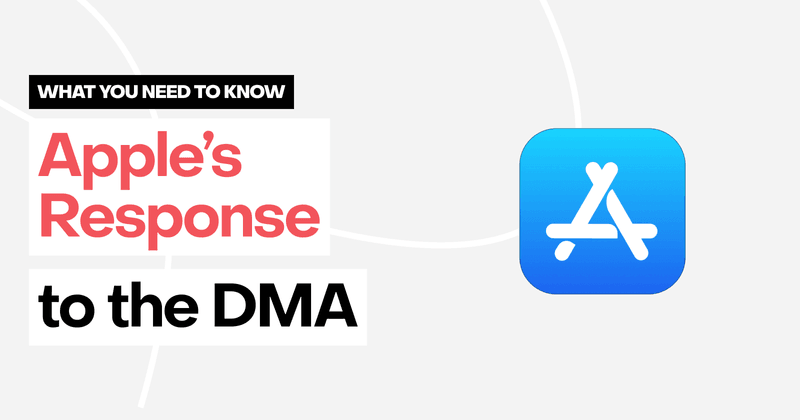Apple’s response to the EU’s Digital Markets Act: What app developers need to know
Making sense of Apple’s sweeping changes to App Store policies in the EU

On January 25th, Apple revealed how its going to comply with the EU’s Digital Markets Act. Slack threads across the world exploded with endless debates on what these changes actually mean.
After hours of reading and analysis, on Friday we hosted a panel of experts (embedded below) to discuss these changes live. The changes and their implications are dizzying. This makes it tough to fully wrap one’s head around the potential impact of accepting the new options Apple is offering developers.
Let’s dive into what these changes mean, and how they may (or may not) impact your mobile business.
Understanding the EU’s Digital Markets Act
First, a bit of background. Apple’s not doing this because they want to. They’re being forced to as part of the EU’s Digital Markets Act (DMA).
The DMA sets regulations for large tech platforms, termed as “gatekeepers,” to ensure “fair competition” in the digital space. Here’s what it means for subscription app developers across all platforms:
- Third-party app stores: Developers can offer apps outside of traditional app stores, potentially reaching users more directly and with apps Apple might not otherwise approve.
- Alternative payment options: The DMA allows for alternative in-app payment systems, giving developers the freedom to choose payment processing options that may offer better terms or features.
- Data sharing: Developers will have access to performance data for their ads and apps, helping them make informed decisions about marketing and app performance.
- Interoperability: For apps that involve communication, the DMA aims to ensure they can work across different platforms and services.
The EU’s goal is to level the playing field, giving developers more control and flexibility while ensuring users have more choices.
New App Store terms for apps in the EU
In response, Apple offers a new set of EU business terms for developers to choose from. They can either adopt these or stick with the old terms. Each choice leads to a decision tree with many implications.

Old terms vs new
If developers choose to stay with the old business terms, very little changes! Apps will still be required to use Apple’s in-app purchases for digital goods. Apple will take a 30% commission on all sales, or a 15% commission for year-two subscriptions and developers in the small business program. And all app updates will have to go through App Review and follow the same guidelines as before. Confusingly, there are some new rules, such as third-party browser engines being allowed, that will apply even if you don’t accept the new terms.
Apps that accept the new terms will have multiple new options available to them within the EU. There will be a new set of relaxed App Review guidelines that allow more flexibility than before, including the use of new APIs that were previously unavailable to developers and will continue to be restricted outside the EU.
Fees paid to Apple will also change fairly dramatically depending on the next few decisions you make such as which payment processor you use, or how you distribute your apps. But no matter what, all developers adopting the new terms will be subject to the Core Technology Fee (CTF).
Apple charges a Core Technology Fee of €0.50 for each first annual install of your app beyond the first million. “First annual install” includes each time a user installs, reinstalls, or updates your app in a year. While Apple’s support documentation explains some nuances, essentially, every user beyond the first million with your app on their phone costs €0.50 each year.
Alternative app stores, AKA marketplace apps
For developers that decide to accept the new business terms in the EU, the next choice they’ll have to make is whether to continue distributing their app through Apple’s App Store, distribute through one of the new alternative app marketplaces, or blend the two and distribute through both.
Alternative app marketplaces are essentially full replacements to the app store. They will have their own app review, guidelines, and business models. Apps distributed through these marketplaces will not have to pay Apple any form of commission on in-app revenue, however they will still be subject to the Core Technology Fee described above. However, marketplace apps will not get 1M free installs per year, a marketplace app will have to pay for every first annual install/reinstall/update. And every app distributed via that marketplace will still have to pay the CTF as well.
Marketplace apps won’t undergo App Review, freeing them from Apple’s App Review Guidelines. This opens up possibilities for entirely new app categories! However, all apps distributed through alternative marketplaces must still get Apple’s notarization and undergo human review for malware, viruses, or security issues.
Apps downloaded via marketplace apps will also display an Apple generated summary of the app’s metadata that was gleaned from that notarization and human review process. Here’s what that will look like:

It’s worth noting that you can distribute apps through both Apple’s App Store and alternative marketplaces. However, iOS lets only one version of an app stay on a phone at a time. If an app comes from another marketplace, it doesn’t get deleted automatically. For example, if Spotify appears in a marketplace app, a user with the App Store version must delete it manually before downloading from the new marketplace.
Developers distributing through alternative marketplaces also cannot use Apple’s in-app purchases for processing payments. They must use a third-party payment processor if distributing outside of the App Store.
Third-party payment processors
If a developer chooses to adopt the new terms, but still wants to distribute through Apple’s App Store, developers now have multiple choices for how to process payments from users.
- Use Apple’s in-app payments just like before
- Use a third-party payment processor
- Link out to the web for payments
In every case, Apple is dropping its commission for developers under the new terms to 17% (or 10% for small businesses and year-two subscriptions) of all purchases made within an app. Apps using Apple’s native in-app purchases pay an extra 3% fee, totaling 20% (or 13%).
Developers who choose third-party payments or linking out to the web will avoid the 3% fee from Apple, but will still have to pay Apple’s 17% (or 10%) commission plus whatever third-party payment processing fees they incur. There are also some additional guidelines these apps must follow. Before initiating a third-party purchase or linking out to the web, apps must present a “scaresheet” warning users that the payment they are about to make is not going through Apple’s native system.

It’s important to note that in addition to these fees, apps distributed through the App Store from developers who’ve adopted the new terms will all be subject to the Core Technology Fee described earlier. This applies whether the app uses Apple’s native in-app purchases, third-party payments, or external linking.
Are the new terms worth it?
As it stands right now, it’s hard to recommend anybody accept the new terms. The Core Technology Fee represents too much risk for too little upside for 99.99% of the people reading this article.
However, as Nico Wittenborn presented during our live panel discussion, there might be some niche opportunities. Apps with a low volume of installs but high average revenue per user (ARPU) might be able to absorb the CTF and benefit from the new terms.
Regarding third-party app stores, their economics are feasible only if users install many apps per marketplace or if there’s high revenue per app. Specifically, game marketplaces might have an opportunity here; a high one-time fee per app can lessen the Core Technology Fee’s (CTF) impact, even in years after the first.
A third opportunity, which some entrepreneurial types may be able to take advantage of, is the release of 600 new APIs by Apple. We could see new third-party integrations and applications as a result.
One important thing to keep in mind after reading all of this: Apple just released these new policies last week and some groups are already complaining to the EU that Apple’s rules do not fully comply with the DMA. This is all subject to (and likely to) change in the coming months. Our recommendation at this point is to sit tight and wait to see what happens.
Apple’s response to the EU’s DMA and how you should respond: In summary
- Apple offers optional new terms for developers in response to the DMA, allowing for third-party app stores and payment processors.
- Developers can opt-in to these new terms, but it’s unclear if they can switch back later.
- The new terms introduce various new fees, with the Core Technology Fee (CTF) being the most burdensome, charging €0.50 for each new app install, reinstall, or update per year.
- Most apps should carefully consider the new terms before accepting, especially due to the CTF’s economic impact, which seems unviable for many.
- Some niche apps with low install volumes but high average revenue per user (ARPU) might find opportunities, but predicting outcomes is challenging without benchmarks for these new scenarios.
In the meantime, if you’re looking to save on App Store fees, you should probably explore optimizing for web payments instead.
You might also like
- Blog post
Gamification in apps: A complete guide to using motivation to drive real value
Daily streaks are not the solution - here are 11 better examples
- Blog post
Apple’s June 2025 EU update: one entitlement, three fees, and CTF’s 2026 sunset
What apps in the EU should do after Apple’s DMA tweak.
- Blog post
7 Meta ad testing frameworks for subscription apps
Balancing speed and accuracy with creative testing

